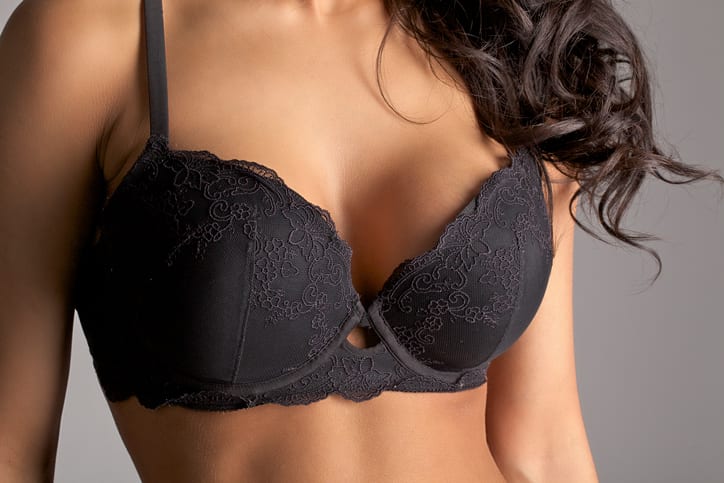
Benefits and downsides of different incision locations
There are four incision locations: areola, inframammary crease, transaxillary, and transumbilical. Each has pluses and minuses.
Areola — This incision is placed just outside of the areola, the darker pigmented skin surrounding the nipple. This incision will be well hidden when you’re fully healed. Through this incision, the implants can be placed either over or under the pectoral muscle.
On the downside, this incision location limits the size of silicone implants, as they are pre-filled and will have to fit through the incision. Also, there is a higher risk of loss of nipple sensation and the future ability to breastfeed with areolar incisions.
Inframammary crease — This incision is made along the crease at the bottom of the breast. It is usually placed just about the crease to hide it under a bikini or lingerie. This incision offers the best view and control for Dr. Kearney. Implants can be placed either above or below the chest muscle through the crease.
On the downside, this incision leaves the most visible scarring. To place implants beneath the muscle, it will have to be cut to gain access, which complicates your recovery.
Transaxillary — Here the incision is made vertically in the armpit. Dr. Kearney uses an endoscope to provide a view of the breast pocket. Obviously, this incision leaves no scarring on the breasts, and even the scar in the armpit becomes almost invisible. Placing the implants under the pectoral muscle doesn’t require any cutting of the muscle. The implants don’t come in contact with the milk ducts, where bacteria can cause inflammation and capsular contracture with areola and inframammary incisions. Larger implant sizes can be accommodated.
On the downside, this incision does limit the placement of extra large silicone implants. There is also a slight risk of the implant coming into contact with bacteria because it rubs against the skin during insertion. Wearing deodorant will necessarily be prohibited for around two weeks.
Transumbilical — In this technique, the implants are inserted through the belly button. This incision is the rarest of the four options, by a long way. An endoscope is used to provide a view of the inside of the body. Scarring is virtually nil, as the incision occurs inside the belly button. Only one incision is required for both breasts. Recovery is usually easier, since this method is less invasive than the other three options. There are no scars on the breasts.
There are some downsides with belly button insertion. Almost any revision work or implant replacement cannot be done through the belly button incision. Silicone implants cannot be placed with this method. Bleeding is more difficult to control. There is also a slightly higher risk of damaging the implant during this placement.
During your consultation with Dr. Kearney, the two of you will discuss your incision choices and how you feel about each option. He’ll give you as much information as possible to help you with your decision.
Are you interested in breast augmentation with Dr. Kearney? Call us at (858) 677-9352 to schedule a consultation.

